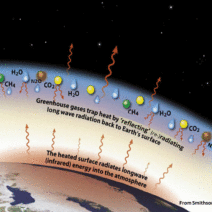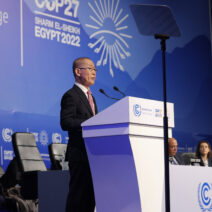The phenomenon of global warming has emerged as one of the most pressing challenges confronting humanity. Understanding the connection between greenhouse gases (GHGs) produced by fossil fuels and the acceleration of this phenomenon is crucial for fostering comprehensive responses to climate change. The interplay of these gases in Earth’s atmosphere results in a complex web of implications that extends to environmental, social, and economic domains.
At the core of this discussion is the greenhouse effect, a natural process that warms the Earth’s surface. Solar radiation reaches the Earth and is absorbed, thereafter being re-radiated as infrared energy back into space. Greenhouse gases trap some of this outgoing energy, preventing it from escaping into the atmosphere. While this is a necessary phenomenon allowing life to thrive, an excess of GHGs—particularly carbon dioxide (CO2), methane (CH4), and nitrous oxide (N2O)—leads to an enhanced greenhouse effect, resulting in a rise in global temperatures.
Fossil fuels—coal, oil, and natural gas—are the primary culprits in this accelerated warming. When combusted for energy production, they release significant quantities of CO2. This increase in atmospheric CO2 levels contributes to the formation of a thickening blanket of gas around the Earth, which can result in elevated temperatures, erratic weather patterns, and an overall destabilization of climate systems. As industrial activity and energy consumption burgeon globally, an inexorable influx of CO2 exacerbates this dilemma. But how does this process unfold?
To grasp the acceleration of global warming, one must first appreciate the concept of carbon footprints, a measure of the total greenhouse gases—primarily CO2—emitted directly or indirectly by an individual, organization, event, or product. Fossil fuel combustion represents one of the most significant contributors to the global carbon footprint. Every gallon of gasoline consumed releases approximately 8.89 kg of CO2 into the atmosphere. Consequently, as society continues its reliance on fossil fuels for transportation, heating, and electricity generation, the cumulative effects of these emissions become increasingly pronounced.
Methane, the second most prevalent greenhouse gas, is released during the extraction and transportation of fossil fuels, particularly natural gas. Understanding the potency of methane is crucial; it has a global warming potential that is approximately 25 times greater than that of CO2 over a 100-year period. Thus, even small emissions of methane can have disproportionately large effects on global warming. With the increasing popularity of natural gas as an alternative to coal, attention must be directed to methane emissions despite its status as a cleaner-burning fuel.
Furthermore, nitrous oxide, while less abundant, holds significant implications for global warming. This gas is released from fossil fuel combustion and agricultural practices, linked to fertilizers and other chemicals. Its global warming potential is about 298 times that of CO2 over a century, emphasizing the need for vigilance in mitigating emissions from various sources, including fossil fuel combustion.
The feedback loops associated with greenhouse gas emissions further amplify the challenges posed by fossil fuels. As global temperatures rise, polar ice melts and permafrost thaws, releasing additional methane and CO2 previously locked in ice and soil. This cycle intensifies warming, creating a precarious situation where proactive measures become increasingly essential. The need for innovation in energy production and utilization, coupled with strategies for carbon capture and sustainable practices, has never been more pressing.
The climate crisis obliges a paradigm shift, not merely in energy policies but also in individual habits. Transitioning to renewable energy sources—such as solar, wind, and hydroelectric power—promises a reduction in reliance on fossil fuels. Such alternatives do not emit GHGs during operation, significantly lowering their carbon footprint. Moreover, embracing energy efficiency practices can reduce the demand for energy derived from fossil fuels, catalyzing beneficial changes for the environment.
Additionally, technological advancements present tantalizing prospects for curtailing GHG emissions from fossil fuels. Innovations in carbon capture and storage (CCS) offer promising avenues to mitigate the adverse effects of fossil fuel combustion, encapsulating CO2 before it escapes into the atmosphere. This technology is still in its nascent stages, yet its potential for industrial application could serve as a critical tool in managing emissions while retaining existing energy infrastructures.
Beyond technical solutions, educational and advocacy initiatives play vital roles in driving change. Raising awareness about the severe impacts of fossil fuel consumption and its link to climate change can motivate individuals and communities to adopt more sustainable practices. Grassroots efforts can engender transformative social movements that redefine norms and standard practices globally.
Pursuing a sustainable future requires collective action from individuals, businesses, and governments. Achieving significant reductions in greenhouse gas emissions necessitates policies that promote cleaner energy, rigorous emissions standards, and incentivizing research and development in renewable technologies. The integration of climate action into governmental agendas will be critical to addressing the existential threat posed by climate change effectively.
In conclusion, the acceleration of global warming, driven by greenhouse gases from fossil fuels, is a multifaceted dilemma that demands urgent, comprehensive responses. Understanding this relationship urges the exploration of innovative solutions, educational outreach, and policy reform that prioritizes both environmental integrity and human well-being. A collective awakening to the urgency of this crisis can pivot humanity towards a more sustainable existence, fostering environmental stewardship for generations to come.






